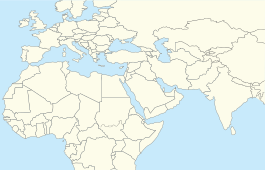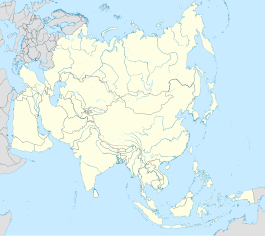Nabi Habeel Mosque
This article needs additional citations for verification. (November 2015) |
| Nabi Habeel Mosque | |
|---|---|
مَسْجِد ٱلنَّبِي هَابِيْل | |
 | |
| Religion | |
| Affiliation | Islam |
| Location | |
| Location | Bilad Ash-Sham |
 Location in Syria | |
| Geographic coordinates | 33°37′17″N 36°6′22″E / 33.62139°N 36.10611°E |
| Architecture | |
| Type | Mosque |
| Style | Islamic |
| Completed | 1599 |
Nabi Habeel Mosque (Arabic: مَسْجِد ٱلنَّبِي هَابِيْل, romanized: Masjid An-Nabī Hābīl; Turkish: Nabi Habeel Camii), or "Mosque of the Prophet Abel", is a shrine dedicated to Habeel, located on the west mountains of Damascus, near the Zabadani Valley, overlooking the villages of the Barada river (Wadi Barada), in Syria, the Levant.[1]
Description[]

This mosque is believed to contain the grave of Abel (Arabic: Hābīl) the son of Adam, as believed by Muslims, who are frequent visitors of this mosque for ziyarat. The mosque was built by Ottoman Wali Ahmad Pasha in 1599, and it is said to have 40 mihrabs. As the story goes, Abel was killed by his brother Cain (Arabic: Qābīl), which is known to be the first homicide of mankind.[2]
Inside the mosque is a 23 ft (7.0 m) long sarcophagus covered with green silk tapestry inscribed with verses from the Qur'an, with some locals saying that this was the size of the world's builders, including Abel.[2] The mosque is also believed to be a ritual site for the Druze.[1]
See also[]
- Holiest sites in Islam
- Holiest sites in Islam (Shia)
- Al-Nabi Shayth, Lebanon
- Baab Sagheer
- Sayyidah Ruqayya Mosque
- Sayyidah Zaynab Mosque
- Holiest sites in Islam (Shia)
References[]
- ^ a b Syria. "Homeland Syria". homelandsyria.com. Retrieved 2019-08-14.
- ^ a b Habeeb Salloum (3 May 2017). "Searching The Environs Of Damascus For Abel's Tomb". Arabamerica.com. Retrieved 12 August 2017.
- 16th-century mosques
- Religious buildings and structures completed in 1599
- Cain and Abel
- Ottoman mosques in Syria
- Mausoleums in Syria
- Mosques in Damascus
- Architecture of Syria
- Tombs of biblical people
- Mosque buildings with domes
- Syrian mosque stubs






